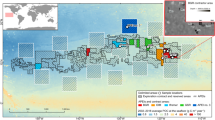Abstract
Recent and ancient carbonate platforms are major marine ecosystems, built by various carbonate-secreting organisms with different sensitivity for environmental change. For this reason, carbonate platforms are excellent sensors for changes in contemporaneous marine environments. A variety of ecosystem changes in carbonate platforms have previously been recognised in the aftermath of mass extinction events. This paper addresses how two Silurian extinction events among graptolites, conodonts, and pentamerid brachiopods can be related to changes in the style of carbonate production and general evolution of low latitude carbonate platforms in a similar way as previously reported from the major five mass extinctions of the Phanerozoic. Strata formed on Gotland during the Mulde and Lau events share remarkably many similarities but are strikingly different in composition compared to other strata on the island. The event-related strata is characterised by the sudden appearance of widespread oolites, deviating reef composition, flat-pebble conglomerates, abundant micro- and macro-oncoids, stromatolites, and other microbial facies suggesting decreased bioturbation levels in contemporaneous shelf seas. Importantly, these changes can be tied to high-resolution biostratigraphic frameworks and global stable isotope excursions. The anomalous intervals may therefore be searched for elsewhere in order to test their regional or global significance.



Similar content being viewed by others
References
Baarli BG, Johnson ME, Antoshkina AI (2003) Silurian stratigraphy and palaeogeography of Baltica. In: Landing E, Johnson ME (eds) Silurian lands and seas—paleogeography outside of Laurentia. New York State Mus Bull 493:3–34
Bickert T, Pätzold J, Samtleben C, Munnecke A (1997) Paleoenvironmental changes in the Silurian indicated by stable isotopes in brachiopod shells from Gotland, Sweden. Geochim Cosmochim Acta 61:2717–2730
Boucot AJ (1991) Developments in Silurian studies since 1839. In: Bassett MG, Lane PD, Edwards D (eds) The Murchison Symposium. Spec Pap Palaeontol 44:91–107
Calner M (1999) Stratigraphy, facies development, and depositional dynamics of the Late Wenlock Fröjel Formation, Gotland, Sweden. GFF 121:13–24
Calner M (2002) A lowstand epikarstic intertidal flat from the middle Silurian of Gotland, Sweden. Sediment Geol 148:389–403
Calner M (2005) A Late Silurian extinction event and anachronistic period. Geology 33:305–308
Calner M, Jeppsson L (2003) Carbonate platform evolution and conodont stratigraphy during the middle Silurian Mulde Event, Gotland, Sweden. Geol Mag 140:173–203
Calner M, Säll E (1999) Transgressive oolites onlapping a Silurian rocky shoreline unconformity, Gotland, Sweden. GFF 121:91–100
Calner M, Sandström O, Mõtus A-M (2000) Significance of a halysitid–heliolitid mud-facies autobiostrome from the Middle Silurian of Gotland, Sweden. Palaios 15:509–521
Calner M, Jeppsson L, Eriksson MJ (2004a) Ytterholmen revisited—implications for the Late Wenlock stratigraphy of Gotland and coeval extinctions. GFF 126:231–241
Calner M, Jeppsson L, Munnecke A (2004b) The Silurian of Gotland—Part I. Review of the stratigraphic framework, event stratigraphy, and stable carbon and oxygen isotope development. In: Munnecke A, Servais T, Schulbert C (eds) Early Palaeozoic palaeogeography and palaeoclimate (IGCP 503). Erlanger Geol Abh Sonderbd 5:113–131
Calner M, Kozłowska-Dawidziuk A, Masiak M (2004c) Correlation of the middle Silurian graptolite crisis and coeval laminated sediments across the Baltic Shield and East European Platform. In: Munnecke A, Servais T, Schulbert C (eds) Early Palaeozoic palaeogeography and palaeoclimate (IGCP 503). Erlanger Geol Abh Sonderbd 5:25–26
Cherns L (1982) Palaeokarst, tidal erosion surfaces and stromatolites in the Silurian Eke formation of Gotland, Sweden. Sedimentology 29:819–833
Grotzinger JP, Knoll AH (1995) Anomalous carbonate precipitates: is the Precambrian the key to the Permian? Palaios 10:578–596
Groves JR, Calner M (2004) Lower Triassic oolites in Tethys: a sedimentologic response to the end-Permian mass extinction. Geol Soc Am Annual Meeting, Denver 2004, Abstr with Progr 36:336
Hagadorn, JW, Bottjer DJ (1997) Wrinkle structures: microbially mediated sedimentary structures common in subtidal siliciclastic settings at the Proterozoic–Phanerozoic transition. Geology 25:1047–1050
Hagadorn JW, Bottjer DJ (1999) Restriction of a late Neoproterozoic biotope: suspect-microbial structures and trace fossils at the Vendian-Cambrian transition. Palaios 14:73–85
Hallock P, Hine AC, Vargo GA, Elrod JA, Jaap WC (1988) Platforms of the Nicaraguan rise: Examples of the sensivity of carbonate sedimentation to excess trophic resources. Geology 16:1104–1107
Hede JE (1925) Gottlands silurstratigrafi. Sve Geol Undersök C 305:1–100
Jaeger H (1991) New standard graptolite zonal sequence after the “big crisis” at the Wenlockian/Ludlovian boundary (Silurian). N Jb Geol Paläont Abh 182:303–354
Jeppsson L (1990) An oceanic model for lithological and faunal changes tested on the Silurian record. J Geol Soc London 147:663–674
Jeppsson L (1997) The anatomy of the mid-early Silurian Ireviken Event. In: Brett C, Baird GC (eds) Paleontological events: stratigraphic, ecological, and evolutionary implications. Columbia University Press, New York, pp 451–492
Jeppsson L, Aldridge RJ (2000) Ludlow (late Silurian) oceanic episodes and events. J Geol Soc London 157:1137–1148
Jeppsson L, Calner M (2003) The Silurian Mulde event and a scenario for secundo–secundo events. Trans Roy Soc Edinburgh, Earth Sci 93:135–154
Jeppsson L, Aldridge RJ, Dorning KJ (1995) Wenlock (Silurian) oceanic episodes and events. J Geol Soc London 152:487–498
Kaljo D, Kiipli T, Martma T (1997) Correlation of carbon isotope event markers through the Wenlock-Pridoli sequence at Ohesaare (Estonia) and Priekule (Latvia). Palaeogeogr Palaeoclimatol Palaeoecol 132:211–223
Kaljo D, Martma T, Männik P, Viira V (2003) Implications of Gondwana glaciations in the Baltic late Ordovician and Silurian and a carbon isotopic test of environmental cyclicity. Bull Soc Geol France 174:59–66
Kaljo D, Brazauskas A, Kaminskas D, Martma T, Musteikis P (2004) The Ludfordian carbon isotope excursion in the Vidukle core, Lithuania, its relations with the Lau Oceanic event and environmental background in NW Baltica. Ber Inst Erdwiss Univ Graz 8:60–62
Klaamann E, Einasto R (1977) Coral reefs of Baltic Silurian (structure, facies relations). In: Kaljo D, Einasto R (eds) Ecostratigraphy of the East Baltic. Acad Sci Estonian Inst Geol, pp 35–41
Koren’ TN (1991) The lundgreni extinction event in central Asia and its bearing on graptolite biochronology within the Homerian. Proceedings of the Estonian Academy of Sciences. Geology 40:74–78
Kozłowski W (2003) Age, sedimentary environment and palaeogeographical position of the late Silurian oolitic beds in the Holy Cross Mountains (Central Poland). Acta Geol Pol 53:341–357
Lehnert O, Fryda J, Buggisch W, Manda S (2003) A first report of the Ludlow Lau event from the Prague Basin (Barrandian, Czech Republic). In: Ortega G, Aceñolaza GF (eds) Proceedings of the 7th International Graptolite Conference and Field Meeting of the International Subcommission on Silurian Stratigraphy: Tucumán 2003, Serie Correlación Geológica, vol 18, pp 139–144
Lenz AC, Kozłowska-Dawidziuk A (2001) Upper Wenlock (Silurian) graptolites of the Arctic Canada: pre-extinction, lundgreni Biozone fauna. Palaeontogr Can 20:1–61
Long DGF (1993) The Burgsvik Beds, an upper Silurian storm generated sand ridge complex in southern Gotland, Sweden. Geol Fören Stockholm Förh 115:299–309
Manten AA (1971) Silurian reefs of Gotland. Dev Sedimentol 13, 539 pp
Mori K (1968) Stromatoporoids from the Silurian of Gotland, I. Stockholm Contrib Geol 19:1–100
Mori K (1970) Stromatoporoids from the Silurian of Gotland, II. Stockholm Contrib Geol 22:1–152
Munnecke A, Samtleben C, Servais T, Vachard D (1999) SEM-observation of calcareous micro- and nannofossils incertae sedis from the Silurian of Gotland, Sweden: preliminary results. Geobios 32:307–314
Munnecke A, Samtleben C, Bickert T (2003) The Ireviken event in the lower Silurian of Gotland, Sweden— relation to similar Palaeozoic and Proterozoic events. Palaeogeogr Palaeoclimatol Palaeoecol 195:99–124
Pharaoh TC (1999) Palaeozoic terranes and their lithospheric boundaries within the trans-European Suture Zone (TESZ): a review. Tectonophysics 314:17–41
Põldvere A. (2003) Ruhnu (500) drill core. Estonian Geol Sect 5:1–76
Poprawa P, Sliaupa S, Stephenson R, Lazauskiene J (1999) Late Vendian–early Palaeozoic tectonic evolution of the Baltic Basin: regional tectonic implications from subsidence analysis. Tectonophysics 314:219–239
Porębska E, Kozłowska-Dawidziuk A, Masiak M (2004) The lundgreni event in the Silurian of the east European Platform, Poland. Palaeogeogr Palaeoclimatol Palaeoecol 213:271–294
Pruss S, Fraiser M, Bottjer DJ (2004) Proliferation of early Triassic wrinkle structures: implications for environmental stress following the end-Permian mass extinction. Geology 32:461–464
Saltzman MR (2001) Silurian δ13C stratigraphy: a view from North America. Geology 29:671–674
Samtleben C, Munnecke A, Bickert T, Pätzold J (1996) The Silurian of Gotland (Sweden): facies interpretation based on stable isotopes in brachiopod shells. Geol Rdsch 85:278–292
Samtleben C, Munnecke A, Bickert T (2000) Development of facies and C/O-isotopes in transects through the Ludlow of Gotland: evidence for global and local influences on a shallow-marine environment. Facies 43:1–38
Schlager W (1991) Depositional bias and environmental change— important factors in sequence stratigraphy. Sediment Geol 70:109–130
Schlager W, Reijmer JJG, Droxler A (1994) Highstand shedding of carbonate platforms. J Sediment Res B 64:270–281
Schubert JK, Bottjer DJ, (1992) Early Triassic stromatolites as post-mass extinction disaster forms. Geology 20:883–886
Sepkoski JJ Jr (1982) Flat-pebble conglomerates, storm deposits, and the Cambrian bottom fauna. In: Einsele G, Seilacher A (eds) Cyclic and event stratification. Springer, Berlin Heidelberg New York, pp 371–385
Sepkoski JJ Jr, Bambach RK, Droser ML (1991) Secular changes in Phanerozoic event bedding and the biological overprint. In: Einsele G, Ricken W, Seilacher A (eds) Cycles and events in stratigraphy. Springer, Berlin Heidelberg New York, pp 298–312
Sheehan PM, Harris MT (2004) Microbialite resurgence after the late Ordovician extinction. Nature 430:75–77
Stel JH, de Coo JCM (1977) The Silurian upper Burgsvik and lower Hamra-Sundre Beds, Gotland. Scripta Geol 44:1–43
Talent JA, Mawson R, Andrew AS, Hamilton PJ, Whitford DJ (1993) Middle Palaeozoic extinction events: faunal and isotopic data. Palaeogeogr Palaeoclimatol Palaeoecol 104:139–152
Whalen MT, Day J, Eberli GP, Homewood PW (2002) Microbial carbonates as indicators of environmental change and biotic crises in carbonate systems: examples from the late Devonian, Alberta basin, Canada. Palaeogeogr Palaeoclimatol Palaeoecol 181:127–151
Wigforss-Lange J (1999) Carbon isotope δ13C enrichment in upper Silurian (Withcliffian) marine calcareous rocks in Scania, Sweden. GFF 121:273–279
Woods AD, Bottjer DJ, Mutti M, Morrison J (1999) Lower Triassic large sea-floor carbonate cements: their origin and a mechanism for the prolonged biotic recovery from the end-Permian mass extinction. Geology 27:645–648
Acknowledgements
I am grateful to reviewer Axel Munnecke, who also provided the palaeogeographic map, and to editor André Freiwald for helpful comments to the manuscript. This research was funded by the Swedish National Research Council (VR) and Crafoordska stiftelsen.
Author information
Authors and Affiliations
Corresponding author
Rights and permissions
About this article
Cite this article
Calner, M. Silurian carbonate platforms and extinction events—ecosystem changes exemplified from Gotland, Sweden. Facies 51, 584–591 (2005). https://doi.org/10.1007/s10347-005-0050-0
Received:
Accepted:
Published:
Issue Date:
DOI: https://doi.org/10.1007/s10347-005-0050-0




